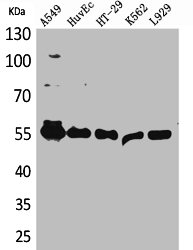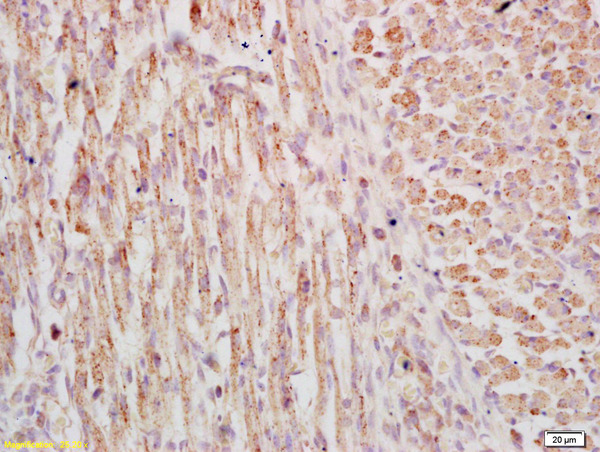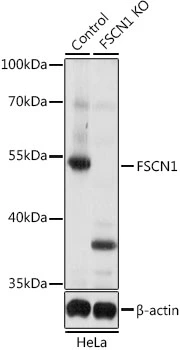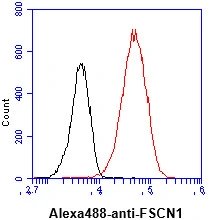![FACS analysis of PFA-fixed K562 cells using GTX34717 Fascin 1 antibody [FSCN1/416]. Blue : Primary antibody Red : Isotype control FACS analysis of PFA-fixed K562 cells using GTX34717 Fascin 1 antibody [FSCN1/416]. Blue : Primary antibody Red : Isotype control](https://www.genetex.com/upload/website/prouct_img/normal/GTX34717/GTX34717_20200115_FACS_1702_w_23051500_724.webp)
FACS analysis of PFA-fixed K562 cells using GTX34717 Fascin 1 antibody [FSCN1/416]. Blue : Primary antibody Red : Isotype control
Fascin 1 antibody [FSCN1/416]
GTX34717
ApplicationsFlow Cytometry, ImmunoFluorescence, Western Blot, ImmunoCytoChemistry, ImmunoHistoChemistry, ImmunoHistoChemistry Paraffin
Product group Antibodies
TargetFSCN1
Overview
- SupplierGeneTex
- Product NameFascin 1 antibody [FSCN1/416]
- Delivery Days Customer9
- Application Supplier NoteWB: 1-2microg/ml. ICC/IF: 1-2microg/ml. IHC-P: 1-2microg/ml for 30 minutes at RT. FACS: 1-2microg/106 cells. *Optimal dilutions/concentrations should be determined by the researcher.Not tested in other applications.
- ApplicationsFlow Cytometry, ImmunoFluorescence, Western Blot, ImmunoCytoChemistry, ImmunoHistoChemistry, ImmunoHistoChemistry Paraffin
- CertificationResearch Use Only
- ClonalityMonoclonal
- Clone IDFSCN1/416
- Concentration0.2 mg/ml
- ConjugateUnconjugated
- Gene ID6624
- Target nameFSCN1
- Target descriptionfascin actin-bundling protein 1
- Target synonymsFAN1, HSN, SNL, p55, fascin, 55 kDa actin-bundling protein, epididymis secretory sperm binding protein, fascin homolog 1, actin-bundling protein, singed-like (fascin homolog, sea urchin)
- HostMouse
- IsotypeIgG2a
- Protein IDQ16658
- Protein NameFascin
- Scientific DescriptionThis gene encodes a member of the fascin family of actin-binding proteins. Fascin proteins organize F-actin into parallel bundles, and are required for the formation of actin-based cellular protrusions. The encoded protein plays a critical role in cell migration, motility, adhesion and cellular interactions. Expression of this gene is known to be regulated by several microRNAs, and overexpression of this gene may play a role in the metastasis of multiple types of cancer by increasing cell motility. Expression of this gene is also a marker for Reed-Sternberg cells in Hodgkins lymphoma. A pseudogene of this gene is located on the long arm of chromosome 15. [provided by RefSeq, Sep 2011]
- Storage Instruction-20°C or -80°C,2°C to 8°C
- UNSPSC12352203

![ICC/IF analysis of HeLa cells using GTX34717 Fascin 1 antibody [FSCN1/416]. Green : Primary antibody Red : nucleus ICC/IF analysis of HeLa cells using GTX34717 Fascin 1 antibody [FSCN1/416]. Green : Primary antibody Red : nucleus](https://www.genetex.com/upload/website/prouct_img/normal/GTX34717/GTX34717_20200115_ICC-IF_220_w_23051500_867.webp)
![IHC-P analysis of human Hodgkins lymphoma tissue using GTX34717 Fascin 1 antibody [FSCN1/416]. IHC-P analysis of human Hodgkins lymphoma tissue using GTX34717 Fascin 1 antibody [FSCN1/416].](https://www.genetex.com/upload/website/prouct_img/normal/GTX34717/GTX34717_20200115_IHC-P_643_w_23051500_376.webp)
![WB analysis of HeLa cell lysate using GTX34717 Fascin 1 antibody [FSCN1/416]. WB analysis of HeLa cell lysate using GTX34717 Fascin 1 antibody [FSCN1/416].](https://www.genetex.com/upload/website/prouct_img/normal/GTX34717/GTX34717_20200115_WB_116_w_23051500_943.webp)





![FACS analysis of PFA-fixed K562 cells using GTX34718 Fascin 1 antibody [FSCN1/417]. Blue : Primary antibody Red : Isotype control](https://www.genetex.com/upload/website/prouct_img/normal/GTX34718/GTX34718_20200115_FACS_1703_w_23060801_317.webp)
![FACS analysis of PFA-fixed K562 cells using GTX34719 Fascin 1 antibody [SPM133]. Blue : Primary antibody Red : Isotype control](https://www.genetex.com/upload/website/prouct_img/normal/GTX34719/GTX34719_20200115_FACS_1705_w_23060801_834.webp)
![FACS analysis of PFA-fixed K562 cells using GTX34720 Fascin 1 antibody [FSCN1/418]. Blue : Primary antibody Red : Isotype control](https://www.genetex.com/upload/website/prouct_img/normal/GTX34720/GTX34720_20200115_FACS_1704_w_23051500_238.webp)
